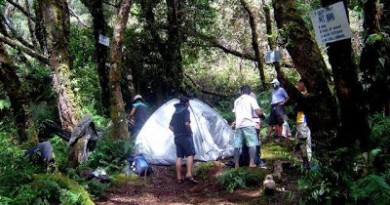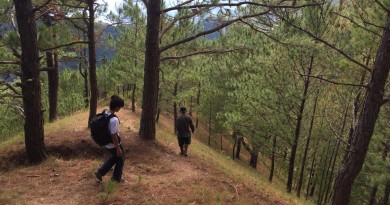Climb health: Five ways to prevent ‘dead toenails’, ‘runner’s toe’ or ‘patay na kuko’
by Gideon Lasco, MD
 This is an article belonging to the ‘climb health‘ category in PinoyMountaineer. The information provided in this article is based on research and clinical experience and are not meant as a substitute to actual medical advice and healthcare.
This is an article belonging to the ‘climb health‘ category in PinoyMountaineer. The information provided in this article is based on research and clinical experience and are not meant as a substitute to actual medical advice and healthcare.
If you are a hiker, then chances are, you have experienced seeing your toenails turn dark after a long climb. The Filipino term we use is “patay na kuko” or dead toenails; the medical term is subungal hematoma; Americans would call it “runner’s toe”.
Although this is not a serious condition – and the toe would eventually grow back to normal (after 6-9 months), it can an unpleasant sight, and can sometimes cause pain because of the pressure built inside the toenail by the hematoma (which means, mass of blood that accumulated). Moreover, it can cause pain when hiking. Thus, whenever possible, this condition should be prevented.
1. Get the right footwear. I learned this the hard way during one of my first climbs when I was a kid: I wore a very tight Adidas shoe on a hike up Makiling. On the ascent, I didn’t feel anything, but when I went down, every step hurt! Sure enough, one or two of my toenails went black the next day. Finding the best shoe for you is often challenging, but as long as you following some basic principles, your toes will be okay. Make sure that when you try on a new shoe, use the socks you’re gonna use to hike when testing it out. Also, make sure that there’s a half-inch allowance between the edge of your toes and the edge of the shoe. This is because there are times when our feet would swell, including warmer months and also after repetitive use. On the other hand, it shouldn’t be too loose either; if it is, then the toes will continually hit the edge of your shoe, making it more prone to ‘dead toenails’.
2. Trim your toenails before you climb. Long toenails would rub off the edge of the shoe, causing repetitive stress to your toenails. There is no need to dig into the corners; just clip them straight across. Since this is a very important thing, you should make it a habit already, of checking your toenails if they’ve been trimmed before every climb. And if a climb is quite long, or you’re on a multi-climb expedition, then bring the nailcutter as well!
3. Tie those shoelaces well. Loose shoes can cause your feet to slide against the shoe edges, causing repetitive stress. This causes the impact of a steep descent to be magnified. Make sure that your shoelaces are tied well, and your shoes are snugly fit. This is the reason why I go for footwear that do not require you to pay much attention to the shoelaces.
4. Proper footwork gets the job done. If you are descending, which part of your feet gets most of the impact? Ideally, the weight of your body is distributed evenly. But if you are not careful, your toes would hit rocks and bear much of the weight and pressure that will eventually kill off your toenails. Thus, keep your eyes on the trail and choose each step well. This is a skill that in time, you will be able to master as the ‘muscle memory’ of your feet improves.
5. Don’t overwhelm your feet by long, continuous descents. I like the Filipino terms ‘nabugbog‘ or ‘natagtag‘ because they correspond well to what happens to the toenails if you ‘punish’ them by a long, continuous descent, especially if you are not accustomed to it. If you begin to feel pain in your toenails, considering resting for a while, and perhaps even taking off your shoes and socks, and stretching / massaging your toes before moving on again.
Of course, sometimes, despite all precautions and preventive measures, the toenails would still die. I experienced this in Mt. Kilimanjaro; I just had to climb for so long on the fifth day (not to mention the cumulative stress on the toenails by a six-day climb) that I couldn’t keep my right big toenail from ‘dying’ (yes, that’s the one on the picture!). In this case, just laugh it out, and wait for it to grow back to normal.
Dead toenails, like limatik bites, are part of hiker’s life.
CLIMB HEALTH
Articles by Gideon Lasco, MD






Leave a Reply
2 Comments on "Climb health: Five ways to prevent ‘dead toenails’, ‘runner’s toe’ or ‘patay na kuko’"
Hi. is it really going back to normal after months? I've got 2@ two dead nails from hiking :'( I am dead worried I read on some articles the deadnail has to be removed or go for a surgery. Please answer me as soon as you can I am so worried
I strongly agree with trimming the toenails, that's why I always bring a toenail cutter and a nail cutter whilst on climb.
Also, try alternating the part of the foot that sets to the ground first. When you feel that your toes are already strained, try using your heels instead of the front part of your foot. Be careful not strain the heels too much because it may lead naman to "basag na tuhod".
Also, don't hold water for too long while on a climb. You will tend to get "manas", wherein your toes will get slightly swollen because of water retention. This will result to pressure on your foot. Your otherwise well-fitted footwear will become a tad bit masikip when you get that climb manas.
-BPS